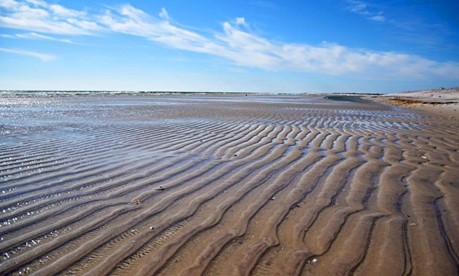
Credit: National Park Service
It may appear that tides come in and out. But that’s not really what happens.
In fact, the Moon pulls the ocean toward it, creating what’s called a “tidal bulge” of higher water surface.
The tidal bulge happens on the side of Earth facing the Moon, with a balancing but slightly lower bulge on the other side of Earth.
As Earth rotates, land masses come into contact with these higher water levels and the tide appears to “come in.” When land rotates past the tidal bulge, the tide “goes out.”
The Sun also pulls on Earth’s oceans, but since it’s so much farther away, its gravitational pull is weaker than the Moon’s.
However, twice a month, the Sun, the Moon and the Earth line up, amplifying the gravitational pull on oceans, causing the highest “spring” tides.
A week later, the Sun is perpendicular to the Moon, pulling the oceans slightly toward it and reducing the tidal bulge, producing the lowest “neap” tides.
The distances of Earth and Moon from the Sun vary through time, impacting gravitational forces that influence tide heights.
And that’s not all. The shape and slope of the shoreline can also affect tides. Long, narrow inlets experience much more dramatic tidal changes than wide, flat shorelines. And high winds from storms can also push high tides further inland than normal.
The Moon remains by far the strongest driver of tides, but the Sun, geography and weather also play a role.
Background
Synopsis: From our Earth-bound perspective, it looks like tides go in and out. But if we were to view Earth from space, we would observe Earth’s daily rotation through two oceanic bulges that are always oriented directly toward Earth’s moon and directly away from it. As coastlines intersect with these bulges twice per lunar day, tides result. While they are predictable, the gravitational pull of the Sun, the seasonal tilt of Earth’s axis, the geography of landmasses and the weather further complicate tides around the globe.
- At the most basic level, the tidal bulges that produce our daily tides are caused by both gravity and inertia.
- Lunar gravity tugs on Earth, creating a bulge as it pulls the water in Earth’s oceans toward the Moon.
- To balance the bulge caused by the Moon’s gravity, a second bulge exists on the opposite side of Earth as a result of inertia. These bulges are fixed, meaning they don’t move.
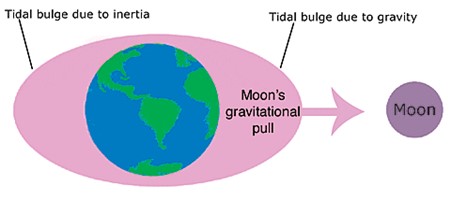
Looking at Earth’s equator, opposing forces of gravity and inertia create two tidal bulges. While you would see the same shape looking down from the poles, if you looked from the Moon toward Earth, it would appear spherical.
Credit: NOAA - If you circled the equator, you would see four distinct “parts” of Earth’s surface water: (1) a bulge facing the Moon caused by lunar gravity, (2) a low, (3) a slightly smaller bulge from inertia facing away from the Moon and (4) a second low.
- As Earth rotates, this is exactly what many coastlines experience: (1) a high tide, (2) a low tide, (3) a slightly lower high tide and (4) a low tide.
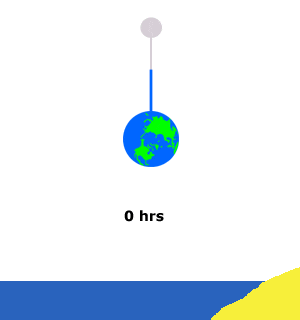
A “solar day” is the time it takes for Earth to rotate 360° under the Sun. We divide it into 24 hours.
A “tidal day” or “lunar day” is the time it takes for the Moon to return exactly overhead above any location on Earth. Because the more distant Moon is moving around Earth in the same direction that Earth is rotating, it takes an extra 50 minutes for Earth to catch up to the Moon.
Credit : NOAA - These are semidiurnal tides with two high tides and two low tides per tidal day (24 hours and 50 minutes). Each high tide is 12 hours and 25 minutes after the previous one.
- The gravitational pull of the Sun adds another component of complexity, operating on the time frame of the lunar month.
- You might think solar gravity would be stronger than lunar gravity, but because of its proximity, the Moon’s gravitational attraction is nearly 2.2 times stronger than the Sun’s.
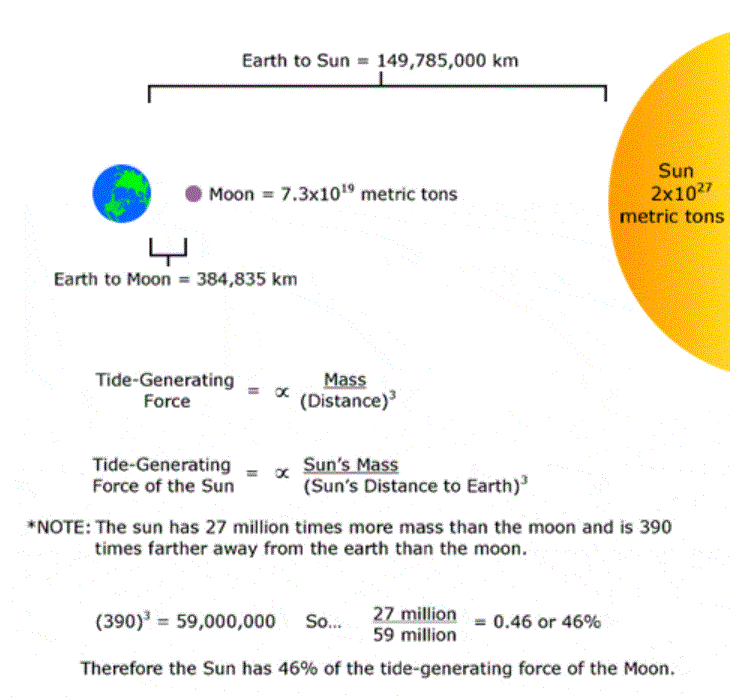
The Earth, Moon and Sun in the new moon phase configuration, when the Moon appears invisible to Earthlings.
Newton’s law of universal gravitation states that the closer objects are, the greater the gravitational force between them. Because it is so far away, the gravitational pull of the Sun on Earth is just 46% of the pull of the Moon, meaning that on Earth, lunar gravity has 2.18 times more attractive force than solar gravity.
Credit: NOAA - A lunar month is the time between successive new moons (about 29 days, 12 hours and 44 minutes), when the Moon is between the Sun and Earth, making it look invisible from our planet because it does not reflect any sunlight back to us.&
- Twice during a lunar month, the Sun aligns with the Moon and Earth in a configuration known as syzygy. During these new moon and full moon times, the gravitational pull of the Sun constructively adds to the gravitational pull of the Moon to produce the largest tidal bulges, producing both the highest and lowest tides of the month, known as spring tides. (The term “spring” tide comes from the German word springen, “to jump.” It does not refer to the season.)
- And one week after every syzygy, the alignment of the Sun and Earth is perpendicular to the alignment of the Moon and Earth, producing quarter moon phases. As the configuration approaches perpendicular, the Sun’s gravity destructively interferes with the pull of lunar gravity, progressively diminishing the tidal bulges to produce the smallest monthly tidal ranges, known as neap tides, during the quarter moons.
- Additionally, once every 27.5 days, our moon’s elliptical orbit brings it 31,000 miles closer to Earth during its perigee, amplifying its gravitational pull and the tidal bulge. But this cycle is not synchronized with the slightly longer lunar month, so the effects vary from month to month.
- You might think solar gravity would be stronger than lunar gravity, but because of its proximity, the Moon’s gravitational attraction is nearly 2.2 times stronger than the Sun’s.
- Further complications arise as a result of Earth’s yearly orbit around our sun, as well as the tug of other celestial bodies. Some amplify the tides, while others shift the tidal bulges away from the equator.
- The 23.5° tilt of Earth’s rotational axis relative to its orbital plane causes our seasons but also tilts the equator, shifting tidal bulges away from the equator. Added to that tilt is the 5° inclination of the Moon’s orbital plane with respect to Earth’s, producing tidal bulges that can occur as much as 28.5° above and below the equator.
- Between these two extremes, which occur at the winter and summer solstices, are the equinoxes in March and September, when the Sun is over Earth’s equator, increasing gravitational alignment to amplify tides.

The path of the Sun, Earth and Moon around the Milky Way. The inclinations of the ecliptic plane and celestial equator are shown with respect to the galactic north pole and galactic plane. The inclination of the Moon's orbit is shown relative to the ecliptic plane. The Solar System traces out a sinusoidal path in its orbit around the galactic center. Using galactic north as the initial frame of reference, the Earth and Sun rotate counterclockwise, and the Earth revolves in a counterclockwise direction around the Sun. However, the Sun and its satellites revolve clockwise around the Milky Way.
Credit: JimSlater307, CC-BY-SA-4.0, via Wikimedia Commons - Earth’s elliptical orbit around the Sun brings it closest to the Sun in January and farther from the Sun in July, changing the gravitational influence of the Sun so that January tides are larger than those in July.
- Studies of deep-sea sediment cores from around the globe have shown that Mars may even tug on Earth to influence the tides on a 2.4 million-year cycle.
- If Earth was a water world, these effects would drive semidiurnal tides around the globe, although their heights would vary. But when the geography of Earth’s continental landmasses and bathymetry of its ocean basins are added to the mix, hundreds of additional variables are added to impact regional and local tides.
- The size, depth, orientation and topography of shorelines, channels and ocean basins influences tides.
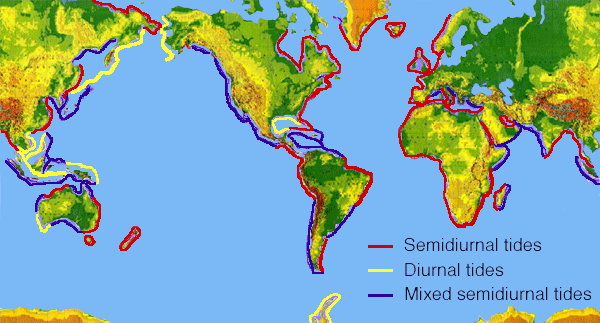
Types of tidal cycles around the world. Atlantic basin coastlines tend to experience semidiurnal tides, while a variety of tidal cycles occur in the Pacific, and much of the Gulf of Mexico coastline is diurnal.
Credit: NOAA
Diurnal (upper left), semidiurnal (upper right) and mixed semidiurnal (lower middle) tide cycles.
An area has a diurnal tidal cycle if it experiences one high and one low tide every lunar day. These tides occur when there is strong interference by continental masses and when basins have narrow inlets. Many areas in the Gulf of Mexico experience these types of tides.
An area has a semidiurnal tidal cycle if it experiences two high and two low tides of approximately equal size every lunar day. Many areas on the eastern coast of North America experience these tidal cycles.
An area has a mixed semidiurnal tidal cycle if it experiences two high and two low tides of different size every lunar day. Many areas on the western coast of North America experience these tidal cycles.
Credit: NOAA - The shape of shorelines can influence local tidal variations, with narrow funnel–shaped inlets focusing tides, amplifying them more than along wide beaches.
- The most extreme tidal ranges occur when the shape and bathymetry of a body of water causes it to oscillate in phase with the tidal period, known as resonance.
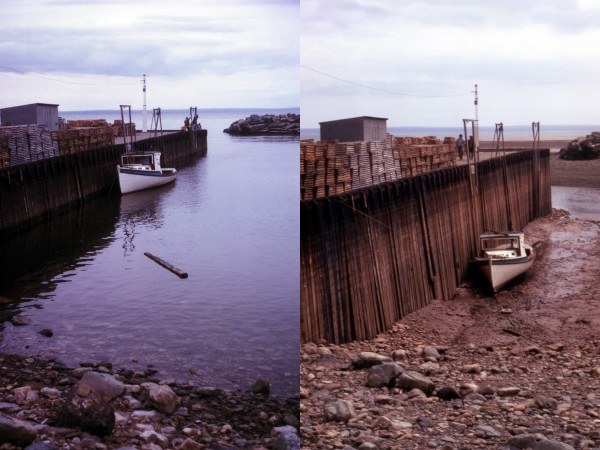
The Bay of Fundy at high tide (left) and 6 hours and 12.5 minutes later, at low tide (right). These boats ride the dramatic tide twice a day.
Credit: Tttrung, CC BY-SA 3.0, via Wikimedia Commons - The largest tidal range on Earth occurs in Eastern Canada’s long, narrow Bay of Fundy, with tidal ranges of up to 52 ft (16 m) that expose as much as 3 mi (5 km) of the bay floor then refill the bay at speeds of up to 11 mph (18 km/h). This resonant semidiurnal tide rolls in and out twice a day like a huge bathtub sloshing back and forth every 12 hours and 25 minutes.
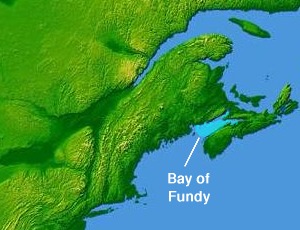
The Bay of Fundy’s funnel-shape and orientation cause it to have the highest tides on Earth, at up to 52 ft (16 m).
Credit: Decumanus at English Wikipedia, CC BY-SA 3.0, via Wikimedia Commons
- The size, depth, orientation and topography of shorelines, channels and ocean basins influences tides.
- Meteorological conditions also impact tides, especially sustained high winds.
- Offshore winds can enhance low tide, exposing more of the basin floor.
- Onshore winds may pile water up along a coastline, amplifying the encroachment of high tides or diminishing low-tide exposures.

